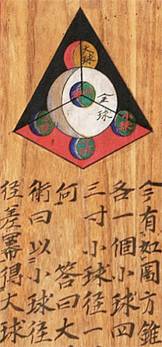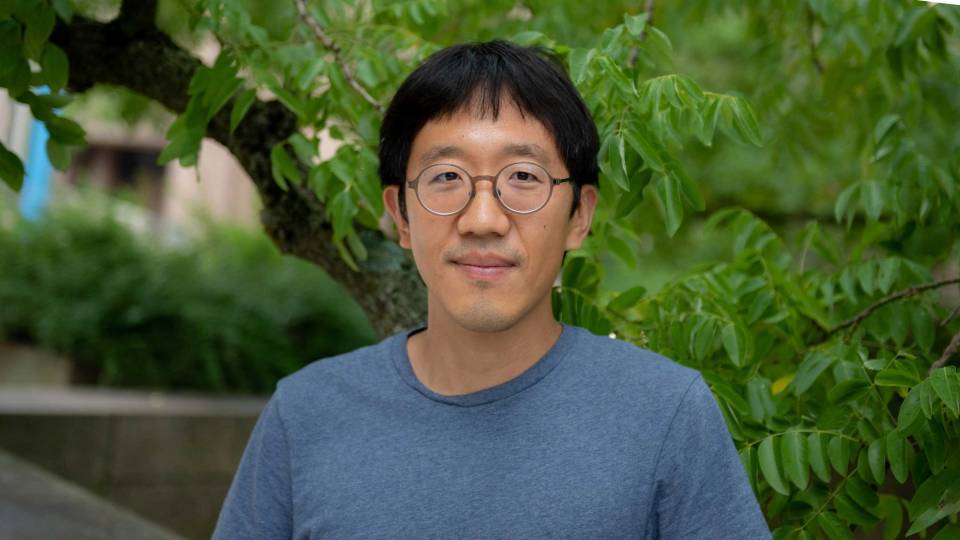From the June 5, 2006, Princeton Weekly Bulletin(Link is external)
Perhaps it’s not surprising that sudoku — the number puzzles that everyone seems to be working on these days — first became popular in Japan before spreading across the ocean. The fad is reminiscent of a math craze that swept the islands centuries ago, when ardent enthusiasts went so far as to turn the most beautiful geometrical solutions into finely illustrated wooden tablets, called sangaku, that adorned the walls of local temples and shrines.
It may be hard to conceive of math as religious art in our day. But equally difficult to imagine is that all this happened while Japan was utterly cut off from the rest of the world, and the country’s scholars were obliged to invent a home-grown branch of mathematics to help them. When Japan opened itself to the world again, the puzzles — and the geometry that helped solve them — fell nearly into oblivion. But after learning of sangaku several years back through a colleague, Princeton’s Tony Rothman is trying to bring this ancient Japanese phenomenon across the sea as well.
“Sangaku tablets are perhaps unique among the world’s cultural creations, as they are simultaneously objects of art, religious offerings and a record of what we might call folk mathematics,” said Rothman, who is a lecturer in the physics department(Link is external) and Pulitzer Prize nominee for his writings on science for the public. “I’m not an expert on any of these subjects, but the aesthetic tradition that created them shines through when you see them all these years later. I think it’s wonderful that a society could consider these finely-wrought expressions of abstract beauty to be worthy of contemplation and inclusion in a temple, as other cultures have valued mosaics, icons or stained-glass windows.”

Rothman has written a few articles on sangaku over the years, and is now working on an illustrated book with Hidetoshi Fukagawa, Japan’s premier authority on the tablets, of which approximately 900 have survived. Both authors say they hope their efforts will bring a little-known aspect of mathematical history to light.
Across the sea
Sangaku became popular in Japan during the Edo period, which lasted from the early 17th century until 1857. Although the rulers had forcibly cut off the island nation from the West — allowing only one Dutch ship a year to make port in Nagasaki — the country experienced a rich cultural flowering. Intellectual pursuits such as mathematics were encouraged, but because of the country’s isolation, Japanese with a flair for the subject were forced to forge their own paths. What developed was a method of answering complex geometrical questions — such as how many circles of a certain size could fit into a particular triangle — without benefit of the techniques of calculus, which were relatively new in Europe at the time.
“Math aficionados of the period did not have access to the advances in math that Gottfried Wilhelm Leibniz and Isaac Newton had made, so they found other approaches,” Rothman said. “To solve problems like these, they used methods similar to those the ancient Greeks used, which were far more time-consuming. They worked fairly well, but you had to be willing to put in some effort.”
While modern mathematical methods, such as calculus, can sometimes simplify a sangaku problem that requires pages of calculation, Rothman said that the advantage to the math used in sangaku problems was that it was simple enough for young children to use, which opened the problems up to nearly anyone who wished to try them.
“Some of the tablets feature solutions provided by 12-year-olds,” he said. “But that doesn’t mean they were easy. Today’s high school geometry problems tend to require only five or six lines to solve, whereas the old problems often demand pages and pages of work. Sangaku were more like math Olympics problems, or the sort of thing your teacher might have put on the wall for extra credit.”
An additional complication is that the tablets were inscribed in Kanbun, a form of Chinese that, similar to Latin in the West, was the language of scholarship in Japan.
“Kanbun was not understandable to the average Japanese person even when the tablets were made,” Rothman said. “Even three centuries ago, they required footnote-like annotation to make them understandable. Now the tablets might be all but incomprehensible, were it not for the colorful accompanying illustrations of the geometry itself.”
Yet the images and math together made the tablets worthy to be given as offerings to Buddhist temples or Shinto shrines in lieu of money or animals, which were more common gifts.
“One sangaku hung in 1815 has a preface, in which a mathematician and his disciples introduce their work,” Rothman said. “Their inscription reads, ‘In this shrine, we ask god for progress in our mathematical ability and dedicate a sangaku.’ They took the religious aspect of their work seriously.”
Joining forces
As the years have passed, however, it has taken the near-religious dedication of Fukagawa, Rothman’s co-author, to bring sangaku back even for Japanese audiences.
“When I was young, everyone, myself included, thought studying these old tablets was a complete waste of time,” said Fukagawa, a 63-year-old high school teacher in Japan who holds a Ph.D. in math. “But a historian friend of mine asked me to help him translate an old book on the subject, and I realized that these Edo mathematicians had worked some sophisticated problems without the tools we take for granted today. I’ve been in love with sangaku ever since and have tried to help find surviving examples of them.”
Recognizing a sangaku tablet for what it is often proves easy enough — which is helpful, as they still turn up in temples from time to time — but deciphering them generally requires Fukagawa’s assistance.
“He’s about the only person around who can make sense of them,” Rothman said. “Now and again someone will be repairing a temple, and the contractors will find that a sangaku tablet had been used as a spare panel for the ceiling and forgotten. Usually it needs some cleaning, and then they call Hidetoshi.”
Rothman himself discovered sangaku in 1989, when his Princeton colleague Freeman Dyson showed him a new book, “Japanese Temple Geometry Problems,” co-written by Dyson’s former teacher Dan Pedoe and Fukagawa. Rothman was sufficiently intrigued to contact Fukagawa, and the two are collaborating via e-mail on another, more lavishly illustrated book, despite being on opposite sides of the world.
“We’ve actually never met,” laughed Rothman, who has yet to visit Japan. “Luckily math is universal. But the problems themselves can be extremely obscure occasionally. Sometimes I have to look at the solution just to figure out what’s being asked.”
When they are finished, Rothman said, the book will include more than just the problems themselves. They hope to have everything from color photos of the better-preserved tablets to excerpts from the diary of an itinerant mathematician from the 19th century, who took several walking tours of Japan specifically to look at sangaku. The book has been slated for future publication by Princeton University Press.
For both authors, the work has been primarily a labor of love. Fukagawa has never received any subsidy for his efforts, but has maintained interest in sangaku for decades.
“I am always looking for ways to use sangaku to help my students, but there’s a better reason to study them than just as a source of new math problems,” he said. “It’s important to remember that sangaku were created and displayed primarily for enjoyment. Some people in those days had an interest in haiku or art, while some enjoyed math, and saw something beautiful in it.”
Rothman admits that he is still learning about the cultural milieu that produced the tablets, but has found beauty in them as well.
“For all I know, this might have been feudal Japan’s version of crossword puzzles — one way the people kept their minds sharp,” Rothman said. “But in any case, sangaku tablets are a part of the world’s cultural heritage. That’s a big reason I’d like to see them preserved.”





